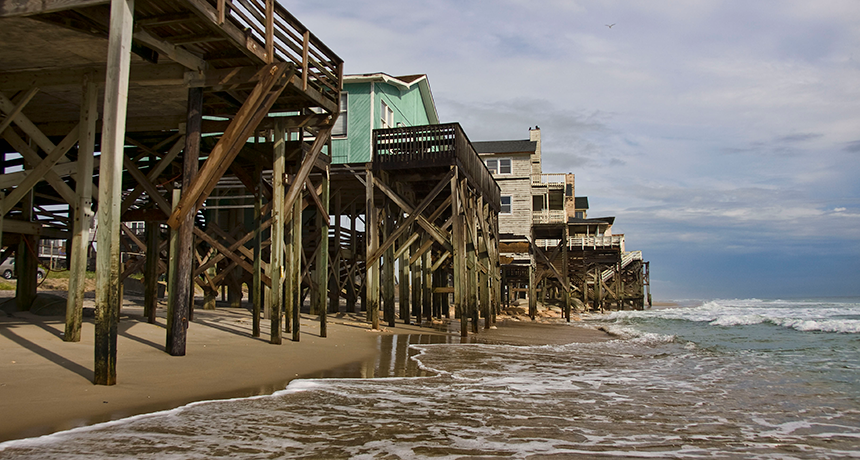How three coastal communities are dealing with rising seas
There are many ways to react when the ocean encroaches

The beach that used to be in front of these North Carolina homes has eroded away. Such land loss can eventually undermine and destroy the buildings.
summersetretrievers/iStockphoto
Around the world, rising seas pose a major threat to coastal communities. Flooding will likely become worse, damaging buildings where people live and work. People who reside near the ocean have to change the way they live and build, or get out altogether. Here are how a few coastal communities are facing climate change by adapting to the new normal.
Losing ground in the “Venice of Africa”
People who live in Saint-Louis are in a daily race against the sea. Saint-Louis is in Senegal, on the west coast of Africa. It’s near where the Senegal River meets the Atlantic Ocean. The seaside city has a rich culture and history. Some people call this place the “Venice of Africa.” (Venice is an Italian city famous for its canals and culture.)
Climate change, however, is putting Saint-Louis in a precarious position. Rising seas and land erosion are bringing the ocean into the city. In 2008, an official with the United Nations called Saint-Louis “the African city most threatened by the rising levels of the sea.” He said this during a conference at a university in Saint-Louis.
On average, Senegal loses a meter (3.3 feet) or more of coastline every day! The encroaching water brings salt water inland. This makes the Senegal River more salty, and its fish have to swim farther upstream for fresh water. Salt water can also poison crops and trees on land. Small fishing villages near Saint-Louis have already vanished. People have left their homes and work behind to move away from the water.
In December 2017, the mayor of Saint-Louis asked other countries for help. The World Bank, which loans money to poor countries at low or no interest rates, provided $30 million in credit. This loan is designed to help the city find new ways to protect itself from the sea and to help the people of Saint-Louis who have had to flee their homes.
Repair, replenish, rebuild, repeat
Every year, thousands of beach-seeking tourists visit the U.S. Outer Banks. This narrow strip of sandy islands sits off the coast of North Carolina. These barrier islands naturally shift to the west as storms erode the shore and blow sand toward the coast.
Climate change is speeding this process. It’s also causing sea level to rise. A study published in August 2017 found that the ocean is rising about 2.5 centimeters (1 inch) per year along some parts of the U.S. East Coast. That’s faster than previous studies had predicted. Higher water levels wash away more sand, boosting erosion. Some homes have collapsed or been demolished as the rising water erodes away the sand beneath them.
Every year, the ocean takes away about 2 meters (6 feet) from the beaches of Nags Head, a popular tourist destination. Some beaches lose 3 meters. The city’s response has been to fight back. The government has hired construction firms to move sand from the ocean floor to the beach. This process is called “nourishing.” But it’s very expensive. Climate scientists also say it’s futile.
An artificial island in a tropical paradise
Hulhumalé is being constructed as a place that’s resilient to climate change. It’s already unusual. The artificial island is part of the Maldives. This tropical nation in the Indian Ocean includes 26 atolls. (An atoll is a ring-shaped formation made of coral.) Atolls in the Maldives are made from thousands of coral islands.
Most land in the Maldives sits less than one meter (3.3 feet) above sea level. The highest natural point, atop a dune, is only 2.4 meters (about 8 feet) high. The Maldives is vulnerable to flooding or being washed away altogether. Computer models predict that sea level may rise by 50 centimeters (1.5 feet) within the next 80 years. If that happens, and nothing changes, nearly 80 percent of the land in the Maldives will disappear beneath the surface.
People in the Maldives are looking for solutions through geoengineering. That involves physically changing the land itself. Engineers created Hulhumalé by moving sand from the sea floor to higher ground. Its walls are being built 3 meters above sea level. The Maldives’ government plans to be done with construction in about five years. By then, the island’s sole city may provide homes to more than 100,000 people.
Conservation International/Youtube







